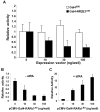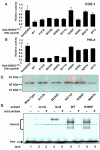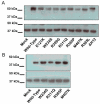The loss of transcriptional inhibition by the photoreceptor-cell specific nuclear receptor (NR2E3) is not a necessary cause of enhanced S-cone syndrome
- PMID: 17438525
- PMCID: PMC2669504
The loss of transcriptional inhibition by the photoreceptor-cell specific nuclear receptor (NR2E3) is not a necessary cause of enhanced S-cone syndrome
Abstract
Purpose: To investigate functional consequence on photoreceptor-cell specific nuclear receptor (NR2E3) transcriptional activity of enhanced S-cone syndrome (ESCS) mutations localized in ligand binding domain (LBD).
Methods: Point mutations were introduced into the LBD of full length and Gal4 chimeric NR2E3 receptors and transcriptional activity was investigated by using transient co-transfection assay on corresponding luciferase reporters. Expression and DNA binding properties of transfected mutant and wild-type receptors were tested by Western blotting and gel shift assay.
Results: Our analysis show that two ESCS mutations, missense mutations R385P and M407K, abolished NR2E3 repressive activity in the context of full-length and Gal4 chimeric receptors, while W234S and R311Q mutants retained their repressive activity in both assays. All mutant receptors maintained their stability and DNA binding ability.
Conclusions: These results showed that NR2E3 mutations localized in LBD induce ESCS disease without affecting inhibitory activity as recorded in vitro. This demonstrates the absence of correlation between transcriptional inhibition and ESCS phenotype. This analysis suggests that NR2E3 might have transcriptional activation properties not yet identified.
Figures






Similar articles
-
Differential dimerization of variants linked to enhanced S-cone sensitivity syndrome (ESCS) located in the NR2E3 ligand-binding domain.Hum Mutat. 2015 Jun;36(6):599-610. doi: 10.1002/humu.22775. Epub 2015 Apr 27. Hum Mutat. 2015. PMID: 25703721 Free PMC article.
-
Novel NR2E3 mutations (R104Q, R334G) associated with a mild form of enhanced S-cone syndrome demonstrate compound heterozygosity.Ophthalmology. 2005 Dec;112(12):2115. doi: 10.1016/j.ophtha.2005.07.002. Epub 2005 Oct 12. Ophthalmology. 2005. PMID: 16225923
-
The photoreceptor-specific nuclear receptor Nr2e3 interacts with Crx and exerts opposing effects on the transcription of rod versus cone genes.Hum Mol Genet. 2005 Mar 15;14(6):747-64. doi: 10.1093/hmg/ddi070. Epub 2005 Feb 2. Hum Mol Genet. 2005. PMID: 15689355
-
NR2E3 mutations in enhanced S-cone sensitivity syndrome (ESCS), Goldmann-Favre syndrome (GFS), clumped pigmentary retinal degeneration (CPRD), and retinitis pigmentosa (RP).Hum Mutat. 2009 Nov;30(11):1475-85. doi: 10.1002/humu.21096. Hum Mutat. 2009. PMID: 19718767 Review.
-
Nr2e3-directed transcriptional regulation of genes involved in photoreceptor development and cell-type specific phototransduction.Exp Eye Res. 2009 Sep;89(3):365-72. doi: 10.1016/j.exer.2009.04.006. Epub 2009 Apr 18. Exp Eye Res. 2009. PMID: 19379737 Free PMC article. Review.
Cited by
-
The crystal structure of the orphan nuclear receptor NR2E3/PNR ligand binding domain reveals a dimeric auto-repressed conformation.PLoS One. 2013 Sep 12;8(9):e74359. doi: 10.1371/journal.pone.0074359. eCollection 2013. PLoS One. 2013. PMID: 24069298 Free PMC article.
-
Heterodimers of photoreceptor-specific nuclear receptor (PNR/NR2E3) and peroxisome proliferator-activated receptor-γ (PPARγ) are disrupted by retinal disease-associated mutations.Cell Death Dis. 2017 Mar 16;8(3):e2677. doi: 10.1038/cddis.2017.98. Cell Death Dis. 2017. PMID: 28300834 Free PMC article.
-
A comprehensive analysis of sequence variants and putative disease-causing mutations in photoreceptor-specific nuclear receptor NR2E3.Mol Vis. 2009 Oct 24;15:2174-84. Mol Vis. 2009. PMID: 19898638 Free PMC article.
References
-
- Jacobson SG, Marmor MF, Kemp CM, Knighton RW. SWS (blue) cone hypersensitivity in a newly identified retinal degeneration. Invest Ophthalmol Vis Sci. 1990;31:827–38. - PubMed
-
- Marmor MF, Jacobson SG, Foerster MH, Kellner U, Weleber RG. Diagnostic clinical findings of a new syndrome with night blindness, maculopathy, and enhanced S cone sensitivity. Am J Ophthalmol. 1990;110:124–34. - PubMed
-
- Jacobson SG, Sumaroka A, Aleman TS, Cideciyan AV, Schwartz SB, Roman AJ, McInnes RR, Sheffield VC, Stone EM, Swaroop A, Wright AF. Nuclear receptor NR2E3 gene mutations distort human retinal laminar architecture and cause an unusual degeneration. Hum Mol Genet. 2004;13:1893–902. - PubMed
-
- Cepko C. Giving in to the blues. Nat Genet. 2000;24:99–100. - PubMed
Publication types
MeSH terms
Substances
LinkOut - more resources
Full Text Sources
Medical
